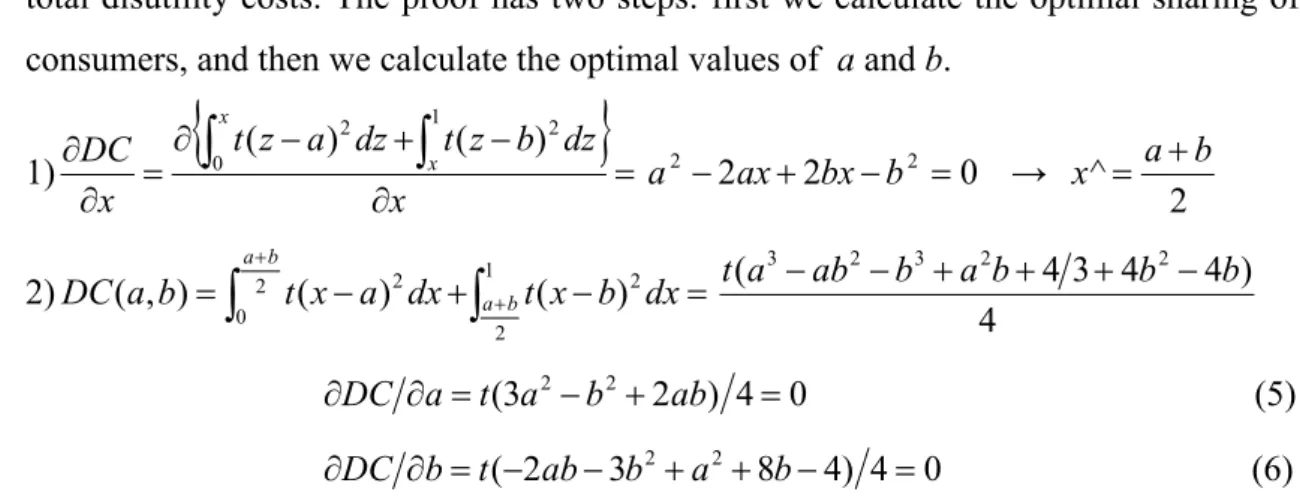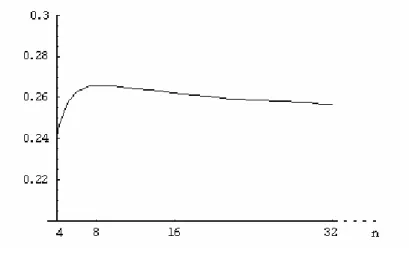In Chapter 1, we provide a selective survey of the most important contributions regarding price discrimination and product differentiation in the Hotelling framework. A selective examination of the most important contributions regarding direct price discrimination and product differentiation in the Hotelling framework is presented.
Price discrimination in monopoly
An even more subtle question is the effect of third-degree price discrimination on aggregate welfare. It can be shown (Schmalensee, 1981; Varian, 1985) that if production does not increase from the uniform price regime to price discrimination, total welfare is lower under price discrimination than under uniform price9.
Competitive price discrimination in spatial models
In Cournot, firms place in the middle of the segment (no differentiation occurs), while in Bertrand firms are moderately differentiated (they locate between the first and the third quartile). In the first stage of the game, each firm commits to uniform prices or does not commit.
Collusion in spatial models
Therefore, variance gains necessarily increase moving from the endpoints to the first and third quartiles of the segment. Instead, the third collusion scheme is easier to maintain than the first when the quality of the information technology is low.
Appendix
By comparing the discriminatory equilibrium price in the left segment with the uniform equilibrium price, it is easy to see that perfect competition may not occur. In particular, the discriminatory equilibrium price is higher than the uniform equilibrium price when: 3x*+1 In this case, firm B is a limited monopolist in market 2 and sets: pB2*=t(b−a)(2x*−a−b) which is higher than the equilibrium unit price when a+b<3x*− 2 .Using a symmetric model with third-degree price discrimination, they show that all equilibrium discriminatory prices are lower than the equilibrium unit price. It is easy to show that the equilibrium discriminatory prices are in each case lower than the equilibrium uniform prices, puA* and puB* 37. Therefore, the equilibrium price under price discrimination is strictly lower than the uniform equilibrium price for low-quality consumers, while the discriminatory equilibrium price is equal to the uniform equilibrium price for high-quality consumers. 2008), “Price Discrimination”, in Handbook of Antitrust Economics, ed. 1998), "Price Discrimination on the Internet: Self-Regulation, Public Policy, and Global Electronic Commerce", wp, The Robert H. Perfect competition usually occurs in the Hotelling (1929) framework with linear or quadratic transportation costs. First, they show that if firms can perfectly price discriminate and simultaneously choose the price schedule, uniform pricing is never an equilibrium. Next, Thisse and Vives (1988) assume a two-stage game, where in the first stage each firm chooses a pricing policy, and in the second stage price schedules are determined. They show that even when each firm can credibly commit to uniform prices before the price schedule is set, the discriminatory prices still arise in equilibrium, since no commitment is the dominant strategy for each firm in the first phase of the game conditioned on the equilibrium path. in the second phase of the game. In contrast, this chapter examines the firms' incentives to price discriminate when the degree of product differentiation is endogenous. In the first version, firms first simultaneously choose which variety to produce, then they choose whether or not to price discriminate, then they set the price schedules. In the appendix, we extend the model to include third-degree price discrimination and show that the main results do not change. The formalization of the product differentiation effect, which was missing (as far as we know) in the price discrimination literature, is the main contribution of this chapter, and we believe that it can increase understanding about firms' incentives to price discriminate. A consumer's utility depends on v, on the price set by the firm he buys from, and on the distance between his preferred variety and the variety produced by the firm. Define by t, equal for all consumers, the importance that the consumer attaches to the distance between his preferred variety and the variety offered by the firm. Given the uniform distribution of consumers, x* is the demand function of firm A and 1−x* is the demand function of firm B. 41 Given the interpretation of the linear market we use, the 'transport costs' are necessarily supported by the consumers: therefore the prices are FOB. However, the linear market can also have a “spatial” interpretation: in this case, each point of the segment represents a point in physical space. Since the distance between a consumer and the firm now implies effective transport costs, two pricing methods are possible: f.o.b. It is immediately clear that all discriminatory equilibrium prices are below the price line under the uniform price regime (perfect competition), and that discriminatory prices fall from consumers located at the endpoints to consumers located in the middle. The curves in the upper part of the graph describe the surplus, gross of the price, of each consumer: the bold curve refers to the uniform price regime, while the thin curve refers to the discriminatory price regime. Under the uniform price regime, the gross consumer surplus is a maximum at points 0 and 1 and a minimum at point 12. In Proposition 4, we state that the surplus for each consumer is higher under price discrimination than under the uniform price regime. For consumers located between 1 and 8 7 8 this is immediate, as both the costs of diffusion and the prices fall from the uniform pricing scheme to the discriminatory pricing scheme. To prove that even for these consumers the surplus is higher under the discriminatory price regime than under the uniform price regime, it is sufficient to compare the surplus of the most external consumers in the two cases, since the consumers are located at points 0 and 1. they are better-off consumers under the uniform price system and the worst-off consumers under the discriminatory price system. As the surplus of these consumers increases from the uniform price system to the discriminatory price system, the same must be true for all other consumers. By replacing pA with the best-response function of firm B, we obtain the equilibrium price schedule for the discriminating firm. It follows that in the second stage of the game the equilibrium is given by both firms. Proposition 7: if in the first stage of the game firm A has chosen U and firm B has chosen D, the equilibrium variants in the second stage are given by a*=13 and. Since it is always positive, firm B is located at the right end of the segment: so b=1. In the hoteling context, the strategic effect dominates the demand effect and firm A is located at the edge of the segment. It is clear that this effect (let's call it the effect of incremental differentiation48) stimulates firm A to move towards the endpoint of the segment. As it turns out, the strategic effect together with the incremental differentiation effect dominate the demand effect and the utility cost minimization effect, and firm A is located at the beginning of the segment. Conclusion A has engaged and firm B has not engaged, the equilibrium prices in the third stage of the game are as follows: Proposition 14: if firm A has chosen U and firm B has chosen D, the equilibrium varieties in the second stage of the game are given by. If firm A has chosen D and firm B has chosen U, the equilibrium varieties in the second stage of the game are given by a*=0 and. Suppose that firm A has chosen U and firm B has chosen D in the first stage of the game. Now consider the necessary conditions on i and j for YOU to occur in the second phase of the game. Therefore, only varietal equilibrium inducing DD can exist in the first stage of the game. When n=2, direct calculations show that the unique equilibrium in the second phase of the game is UU for each a and b. Therefore, the impact of the degree of product differentiation on the viability of a collusion is not a priori an obvious issue. Finally, in the third scheme of collusion, the firms do not directly agree on the price(s), but simply agree not to price discriminate. A related question is the following: which hidden scheme is easiest to maintain in equilibrium for any given degree of product differentiation. The sustainability of the first and third collusive plans does not depend on the degree of product differentiation. Instead, the sustainability of the second collusive arrangement depends negatively on the degree of product differentiation. Finally, in the appendix we extend the analysis of the second and third collusive schemes to a third-price discrimination framework, a la Liu and Serfes, and show that the results do not change. The appendix generalizes the results of the second and third collusion schemes to the case of third-degree price discrimination. The model of differentiated firms Moreover, given the assumption about w, p*≥0 (i.e., the deviating firm's participation constraint is not binding). The sustainability of the optimal covert discriminatory pricing scheme then does not depend on the degree of product differentiation. When firms cooperate on p, the deviant price schedule is: C. of the last inequality decreases linearly in x. That is, when Γ>0 the derivative of the critical discount factor is positive and vice versa. This effect partially offsets the reduction in prices applied to more distant consumers, and therefore deviation profits are less sensitive (in absolute value) to variations in t in the discriminatory pricing model. In general, the dependence of discriminatory equilibrium prices on x reduces the dependence of discriminatory equilibrium prices on t: therefore Nash profits in the discriminatory price model are less sensitive to t relative to the uniform price model. Ceteris paribus, the fact that the profit derivative of the deviation is smaller (in absolute value) in the discriminatory price model increases Γ relative to the uniform price model; the fact that the derivative of Nash profits is smaller in the discriminatory price model reduces Γ relative to the uniform price model; the. The critical discount factor of the first and third collusive schemes does not depend on the position of the companies in the market. Instead, the critical discount factor of the second collusive plan decreases as the degree of product differentiation decreases. What happens to the critical discount factor when companies collude in a suboptimal uniform collusive price? Therefore, collusion on a suboptimal collusive uniform price increases the critical discount factor (or leaves it unchanged when the firms are not differentiated), and this makes collusion less (or equally) tenable. After some manipulations, the derivative of the critical discount factor can be written as follows: Therefore, the derivative of the critical discount factor in relation to the price is always negative. The critical discount factor for the first collusion scheme (optimal collusion over discriminatory pricing) is equal to 1/2 for any degree of product differentiation.Discriminatory prices, endogenous product differentiation and the Prisoner Dilemma problem
Introduction
Uniform price
Perfect discriminatory prices

A three-stage model
Appendix

Product differentiation, price discrimination and collusion
Introduction
The infinitely repeated game
When firms collude not to discriminate, the deviation price schedule is